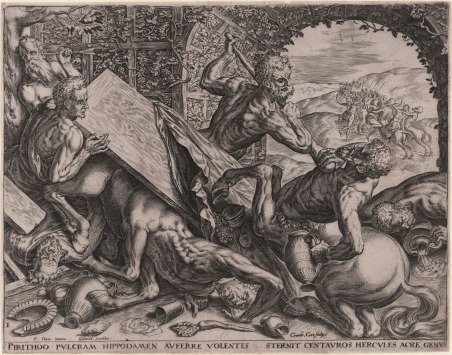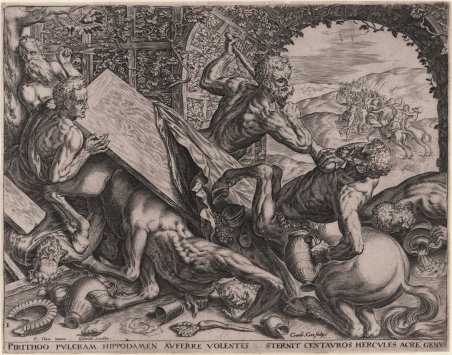Details
Engravers
CORT Cornelis (Hoorn, nr Alkmaar, 1533 - Roma, prima del 22, Aprile 1578)
Description
Bulino, 1565, privo di data, firmato in lastra in basso a destra. Da un dipinto di Frans Floris. Della serie “Le dodici fatiche di Ercole”. Esemplare nel IV stato di IV, descritto da Sellink - Leeflang Eccellente prova, impressa su carta vergata coeva, rifilata al margine, in ottimo stato di conservazione.Questa stampa costituisce la tavola n. 1 di una serie di 10 fogli raffiguranti le fatiche di Ercole, incisa da Cornelis Cort nel 1563 e riproducente altrettanti dipinti di Frans Floris realizzati fra il 1554 ed il 1555 per Nicolaas Jongelinck, mercante e collezionista d'arte di Anversa. Uno solo di questi 10 dipinti è tuttora esistente e si trova in collezione privata; i disegni preparatori per l'esecuzione delle incisioni furono probabilmente eseguiti da Simon Jansz. Kies, allievo di Franz Floris. La serie di incisioni conobbe 4 edizioni, tutte pubblicate ad Anversa: la prima nel 1565, opera di Hieronymus Cock, che pubblica anche la seconda e la terza; mentre la quarta edizine è opera di Justus Goltzius, che corregge l’indirizzo del Cock con il suo. Il soggetto è piuttosto singolare poichè secondo Ovidio non è Ercole bensì Teseo a cacciare i centauri che, invitati al banchetto di nozze di Piritto e Ippodamia, iniziano a comportarsi selvaggiamente finchè uno di essi, Eurito, assale la sposa scatenando una lotta furibonda. Tale episodio non è neppure citato fra quelli leggendari delle fatiche di Ercole. Al verso, timbro di collezione Leroy Kirwin 'Roy' Burket (Lugt 3389) ed un secondo non identificabile. //// Engraving, 1565, signed on plate with the names of the engraver and the editor. After a painting by Franz Floris. From the series The Twelve Labours of Hercules. Example in the IV state of IV, according to Sellink – Leeflang.Excellent work, printed on contemporary laid paper, trimmed on the marginal line, in good condition. The Twelve Labours of Hercules in a suite of 10 engravings, edited for the first time in 1565 by the Antwerp publisher Hieronymus Cock who also published the second and the third edition. The last edition was edited by Justus Goltzius.The engravings reproduce the cycle of paintings made around 1555 by Frans Floris for the residence of the Antwerp merchant Nicolaas Jonghelinck; only one of these paintings has survived. The drawings Cort used as models were probably done by Simon Jansz. Kies, one of Floris’ pupils. The limited amount of space available in the room where the paintings were displayed obliged Floris to compress the twelve works into ten painted compositions, two thematically related episodes being combined on two of the paintings. Cornelis Cort also adopted this procedure but extended Frans Floris’ compositions to include a landscape backdrop. Cort’s engravings stand out for their concentrated, powerful technique and compositional coherence. The somewhat dry, unpolished linework gives the prints great expressive power which dramatically brings out the dynamism and the raw violence of the individual episodes. Cort’s disciplined burin technique with its dense hatching patterns gives both man and beast an almost sculptural plasticity and a tremendous physical presence, while the striking chiaroscuro effectively intensifies the pathos of the individual scenes. The subject is rather strange because according to Ovid is not Hercules but Theseus to hunt the centaurs that were invited to the wedding feast of Piritto and Hippodamia, they begin to behave wildly until one of them, Eurytus, assails the bride unleashing a furious battle. This episode is not even mentioned among those legendary labors of Hercules.Ex collection Leroy Kirwin 'Roy' Burket (Lugt 3389). Sellink M./ Leeflang H., 2000, v. III p. 32 n. 173; The New Hollstein 172–181


Find out how to use
Find out how to use

